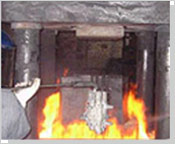 Impression die forging accounts for the majority of forging production. In this process, two dies are brought together. The workpiece is then subjected to plastic deformation till its enlarged sides touch the die side walls. Materials then begins to flow outside the die impression forming flash. As the flash cools down and increase its resistance to deformation, in effect it becomes part of the tool itself. This creates pressure in the bulk of the workpiece and in the process helping the material to flow into the unfilled impression.
Impression die forging accounts for the majority of forging production. In this process, two dies are brought together. The workpiece is then subjected to plastic deformation till its enlarged sides touch the die side walls. Materials then begins to flow outside the die impression forming flash. As the flash cools down and increase its resistance to deformation, in effect it becomes part of the tool itself. This creates pressure in the bulk of the workpiece and in the process helping the material to flow into the unfilled impression.
Precision die forgings that is produced on a horizontal forging machine (upsetter) is known as upsetting. In Upsetting, stock is held between a fixed and moving die while a horizontal ram provides the pressure to forge the stock. After each ram stroke, the multiple-impression dies opens to permit transfer of stock from one cavity to another.
Closed die forging is another form of impression die forging. It does not depend on flash formation to achieve complete filling of the die. Material is deformed in a cavity that allows little or no escape of excess material, thus placing greater demands on die design.
